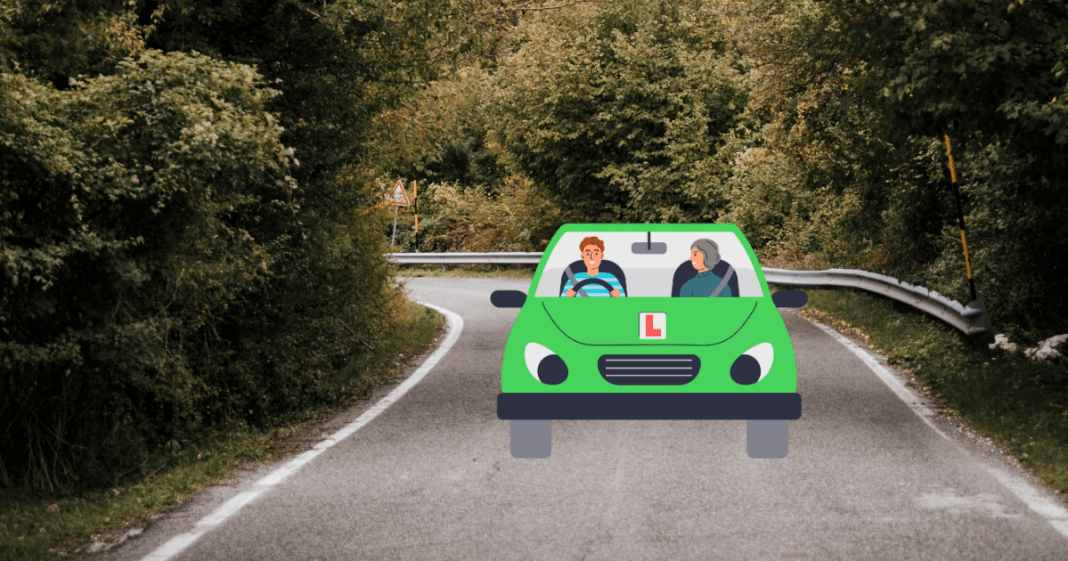Last Updated on March 20, 2025
Learning to drive is an exciting milestone for many young people in the UK. As a learner driver, you must adhere to a variety of rules and regulations, particularly when it comes to driving with passengers. Ensuring the safety of yourself, your passengers, and other road users is crucial. This guide will provide you with essential information on learner driving rules, including who can supervise you, the benefits and risks of driving with passengers as well as tips for a successful learning experience. Understanding these rules will help you navigate the roads confidently and safely as you build your driving skills.

Are Learner Drivers Allowed Passengers?
Yes, learner drivers are allowed to have passengers in the car. However, it’s important to understand the specific regulations and best practices to ensure a safe and productive learning environment. In this comprehensive guide, we answer common questions like “can you have kids in the car when learning to drive” and “who can learner drivers drive with?” Knowing these guidelines will help you stay within the law and make the most of your learning experience while keeping everyone safe.
What You Need to Know About Who Can Accompany You When Learning to Drive
As a learner driver, you must always be accompanied by a qualified supervisor and follow the guidelines set by the DVSA (Driver and Vehicle Standards Agency). Additionally, you need to make sure your car is appropriately insured and displays L-plates on both the front and rear bumper. This ensures that other road users are aware that you are a learner driver, which can lead to more patience and understanding from other drivers. Moreover, adhering to these requirements helps prevent legal issues and enhances your safety and the safety of those around you.
Who Can Supervise Me?
Before considering who else can join you as a passenger, it’s important to clarify who can legally supervise you.
Requirements For Supervising a Learner Driver
| Is seated in the front passenger seat |
| Is over 21 years of age |
| Is qualified to drive the type of vehicle you are learning in e.g they must have a manual car licence if they’re supervising you in a manual car |
| Has held a full driving licence for 3 years (from the UK, EU, Switzerland, Norway, Iceland or Liechtenstein) |
Driving without the right supervision or licence can result in an unlimited fine up to 8 penalty points on your provisional licence. Always ensure that your car is correctly insured and displays L-plates on the front and back of the car to alert other road users that the driver is a learner. Additionally, a properly qualified supervisor can provide valuable guidance and feedback, helping you become a better driver.

How Many Passengers Can I Have In The Car?
As a learner driver, you must have at least one qualified supervisor in the front passenger seat. While it is legal to carry additional passengers, it is generally advisable to limit the number to reduce potential distractions. The number of passengers you can legally carry depends on the vehicle’s capacity. For example, in a typical 5-seater car, you can carry one supervisor in the front passenger seat and up to three passengers in the back seats.
All passengers must wear seatbelts, and appropriate child car seats must be used if carrying children. It’s important to manage the in-car environment carefully to maintain focus on your driving practice. Additionally, consider the potential impact of having multiple passengers on your concentration and ability to respond to driving situations. Reducing the number of passengers can help you stay focused and improve your driving skills more effectively.

What Are the Benefits of Learning to Drive with Passengers?
Driving with passengers can provide valuable experience for learner drivers. It can help you:
- Get accustomed to different driving conditions and potential distractions.
- Build confidence in handling various driving scenarios.
- Prepare for real-world driving where passengers will often be present.
Practicing with passengers can simulate the conditions you’ll face once you pass your driving test, making you a more well-rounded and confident driver. These experiences can also help you develop better communication skills and learn how to handle pressure while driving. Additionally, the presence of passengers can help you get used to the added responsibility and awareness needed when driving with others.
What Are the Risks of Learning to Drive with Passengers?
While there are benefits, there are also risks associated with driving with passengers. These include:
- Increased distractions from noisy or disruptive passengers.
- Added pressure that can affect concentration.
- The vehicle may handle differently when fully loaded with passengers.
Managing these risks effectively involves setting ground rules for your passengers and maintaining a focus on safe driving practices. It’s essential to be aware of how your driving style might change with the added weight and dynamics of multiple passengers. Additionally, consider starting with a single passenger to gradually build up your confidence before taking on more passengers. Learning to manage these factors will contribute to safer driving habits in the future.
Can a Learner Driver Carry Children in the Car?
Yes, learner drivers can carry children in the car, but it’s not always advisable. Children can be particularly distracting, even for experienced drivers. If you choose to practise driving with children in the car, ensure you comply with all legal requirements regarding child car seats and booster seats. It’s important to consider whether having children in the car might detract from your ability to focus on learning to drive. Additionally, think about the potential stress and distraction that children might cause, and weigh it against the benefits of practising driving in a variety of real-world scenarios.
Top Tips for Carrying Passengers as a Learner Driver
Carrying passengers as a learner driver can be challenging but also beneficial. Here are some top tips to help you manage this aspect of your learning experience:
| Get Learner Driver Insurance: Ensure you have appropriate insurance coverage before practising outside of your driving lessons. |
| Limit Passengers: Consider if additional passengers are necessary. If they might cause distractions, it’s better to drive with just your supervising passenger. |
| Plan Your Route: Having a clear route can help reduce stress and make your passengers feel more comfortable. |
| Set Ground Rules: Communicate expectations with your passengers. Ensure they understand the importance of wearing seatbelts and maintaining a calm environment. |
| Stay Focused: Keep your attention on driving. If passengers become distracting, politely ask them to be quieter or less disruptive. |
| Communicate Clearly: Let passengers know about upcoming manoeuvres such as lane changes or braking. This helps everyone in the car be prepared and reduces sudden surprises. |
Night Driving with Passengers as a Learner Driver
Night driving presents a unique set of challenges, particularly for learner drivers. While it is legal for learner drivers to carry passengers at night, there are specific considerations to keep in mind to stay safe:
- Reduced Visibility: Night driving requires heightened awareness as visibility is limited, making it essential to manage distractions from passengers carefully.
- Increased Fatigue: Driving when tired can impact your reaction time and concentration. Passengers can add to this if they are engaging in distracting activities or conversations.
- Practise in Low-Traffic Areas: It’s wise to begin night driving practice with fewer passengers and in less congested areas to help build confidence in reduced light conditions.
As a learner driver, gaining experience at night can be valuable, but ensure you’re comfortable with daytime driving first. Limiting passengers during your first few night drives can help you acclimate to the differences in road conditions and lighting.
Managing Peer Pressure from Passengers as a Learner Driver
Many young drivers may face pressure from friends who want to join them on the road, but it’s important to prioritise safety over peer pressure. Here are some strategies for handling any expectations from passengers while you’re learning:
- Set Boundaries: Make it clear to friends or family that your focus is on safe learning, and any disruptive behaviour is unacceptable.
- Limit Initial Passengers: Start with one or two close, calm passengers to avoid overwhelming situations.
- Communicate Driving Needs: Let your passengers know if you need silence during complex manoeuvres, like parallel parking or merging onto main roads.
Driving with passengers requires full concentration, and managing peer pressure is part of building confidence on the road. Prioritising safe, distraction-free practice now will make you a more capable driver in the future.
Tips for Practising Defensive Driving with Passengers
Defensive driving is an essential skill, especially for learners with passengers. Carrying passengers means extra responsibility, so learning how to anticipate and respond to potential road hazards is crucial:
- Increase Following Distance: Allow for more space between your car and the vehicle in front, especially in adverse weather conditions, to account for your vehicle’s additional weight.
- Anticipate Other Drivers’ Actions: Keep an eye on the behaviour of other road users and anticipate potential hazards, such as sudden braking or unexpected lane changes.
- Minimise In-Car Distractions: Ensure your passengers understand the importance of maintaining a calm environment, helping you focus on defensive driving techniques.
Defensive driving can help learners feel more prepared and in control, making driving with passengers a safer experience. Practising these habits can build your confidence in managing both the road and your passengers responsibly.
Conclusion
Driving with passengers as a learner can be an important part of your driving education. By following the rules and guidelines, setting clear expectations, and managing potential distractions, you can gain valuable experience and build your confidence on the road. Remember to always prioritise safety for yourself and your passengers. Practise makes perfect, and the experience you gain now will serve you well in the future. Get in touch with Collingwood Insurance today for learner driver insurance!
Get a Learner Insurance Quote with Collingwood
FAQs
Yes, but it’s important to ensure they are properly restrained in appropriate car seats and understand the need to remain calm and quiet to avoid distractions. Additionally, consider whether having children in the car is necessary for your practice sessions.
Yes, learner drivers can have passengers, provided they have a qualified supervisor in the front passenger seat and do not exceed the vehicle’s capacity. It’s crucial to manage the number of passengers to maintain focus and safety.
Learner drivers must drive with a qualified supervisor who meets specific legal requirements, but they can also carry additional passengers within the vehicle’s legal capacity. Ensuring the supervisor is experienced and reliable is essential for effective learning.
The car must be insured for the learner driver, equipped with L-plates both front and back, and suitable for the number of passengers carried. Additionally, the vehicle should be in good working condition to ensure safety during practice sessions.
Politely ask them to be quieter or less disruptive. Consider limiting the number of passengers if distractions persist, and always prioritise your focus on safe driving. Effective communication and setting expectations before starting your journey can help minimise distractions.









